Recent progress in chemosensors based on pyrazole derivatives
- PMID: 35515469
- PMCID: PMC9054117
- DOI: 10.1039/d0ra02394a
Recent progress in chemosensors based on pyrazole derivatives
Abstract
Colorimetric and fluorescent probes based on small organic molecules have become important tools in modern biology because they provide dynamic information concerning the localization and quantity of the molecules and ions of interest without the need for genetic engineering of the sample. In the past five years, these probes for ions and molecules have attracted great attention because of their biological, environmental and industrial significance combined with the simplicity and high sensitivity of absorption and fluorescence techniques. Moreover, pyrazole derivatives display a number of remarkable photophysical properties and wide synthetic versatility superior to those of other broadly used scaffolds. This review provides an overview of the recent (2016-2020) findings on chemosensors containing pyrazole derivatives (pyrazoles, pyrazolines and fused pyrazoles). The discussion focuses on the design and physicochemical properties of chemosensors in order to realize their full potential for practical applications in environmental and biological monitoring (sensing of metal ions, anions, explosives, and biomolecules). We also present our conclusions and outlook for the future.
This journal is © The Royal Society of Chemistry.
Conflict of interest statement
The authors declare no competing financial interest.
Figures


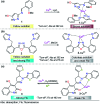
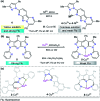





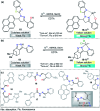


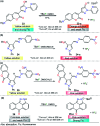
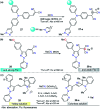
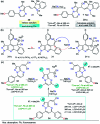





Similar articles
-
An Introductory Overview on Applications of Pyrazoles as Transition Metal Chemosensors.J Fluoresc. 2024 Sep;34(5):1955-1964. doi: 10.1007/s10895-023-03402-0. Epub 2023 Sep 23. J Fluoresc. 2024. PMID: 37740878 Review.
-
Current Advances in Diazoles-based Chemosensors for CN- and FDetection.Curr Org Synth. 2023;20(1):77-95. doi: 10.2174/1570179419666220218095741. Curr Org Synth. 2023. PMID: 35184705 Review.
-
A Review on Pyrazolines as Colorimetric Fluorescent Chemosensors for Cu2.J Fluoresc. 2025 May;35(5):2553-2568. doi: 10.1007/s10895-024-03678-w. Epub 2024 May 24. J Fluoresc. 2025. PMID: 38789859 Review.
-
A Study of Small Molecule-Based Rhodamine-Derived Chemosensors and their Implications in Environmental and Biological Systems from 2012 to 2021: Latest Advancement and Future Prospects.J Fluoresc. 2024 Jan;34(1):15-118. doi: 10.1007/s10895-023-03231-1. Epub 2023 May 22. J Fluoresc. 2024. PMID: 37212978 Review.
-
A Comprehensive Review on Thiophene Based Chemosensors.J Fluoresc. 2022 Jan;32(1):19-56. doi: 10.1007/s10895-021-02833-x. Epub 2021 Oct 8. J Fluoresc. 2022. PMID: 34623559 Free PMC article. Review.
Cited by
-
Novel polycyclic "turn-on" and "turn-off" pyrazoline and pyrazole fluorescent sensors for selective real-world monitoring of Fe3+/Fe2+ in aqueous environments.RSC Adv. 2024 Oct 31;14(47):34918-34924. doi: 10.1039/d4ra06457g. eCollection 2024 Oct 29. RSC Adv. 2024. PMID: 39483388 Free PMC article.
-
Synthesis and Antiproliferative Activity of 2,4,6,7-Tetrasubstituted-2H-pyrazolo[4,3-c]pyridines.Molecules. 2021 Nov 8;26(21):6747. doi: 10.3390/molecules26216747. Molecules. 2021. PMID: 34771163 Free PMC article.
-
3-(4-Formylphenyl)-triazole functionalized coumarins as violet-blue luminophores and n-type semiconductors: synthesis, photophysical, electrochemical and thermal properties.RSC Adv. 2022 Oct 3;12(43):28137-28146. doi: 10.1039/d2ra03266j. eCollection 2022 Sep 28. RSC Adv. 2022. PMID: 36320249 Free PMC article.
-
Active Hydrogen Free, Z-Isomer Selective Isatin Derived "Turn on" Fluorescent Dual Anions Sensor.J Fluoresc. 2025 Jun;35(6):3905-3921. doi: 10.1007/s10895-024-03762-1. Epub 2024 Jun 19. J Fluoresc. 2025. PMID: 38896304
-
Multicomponent Synthesis of New Fluorescent Boron Complexes Derived from 3-Hydroxy-1-phenyl-1H-pyrazole-4-carbaldehyde.Molecules. 2024 Jul 22;29(14):3432. doi: 10.3390/molecules29143432. Molecules. 2024. PMID: 39065010 Free PMC article.
References
-
- Malik L. A. Bashir A. Qureashi A. Pandith A. H. Environ. Chem. Lett. 2019;17:1495–1521. doi: 10.1007/s10311-019-00891-z. - DOI
Publication types
LinkOut - more resources
Full Text Sources
Miscellaneous

